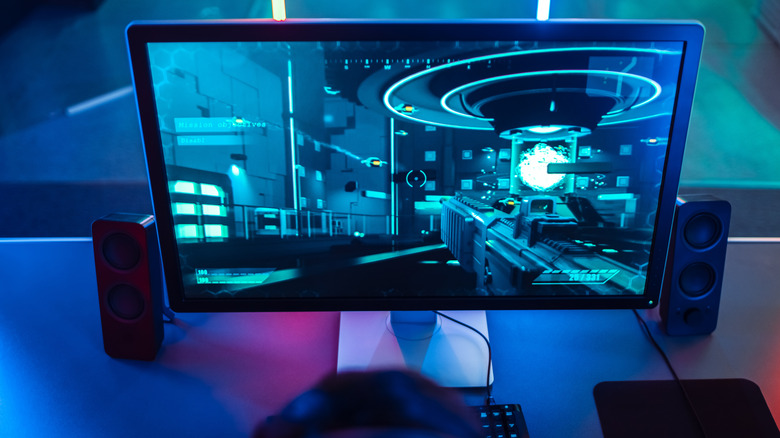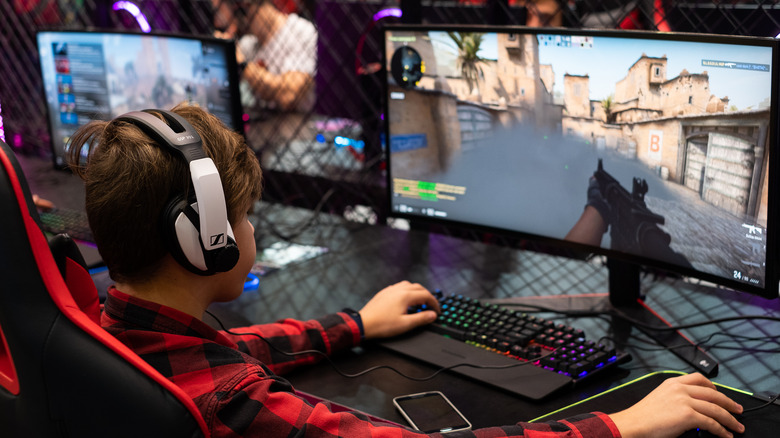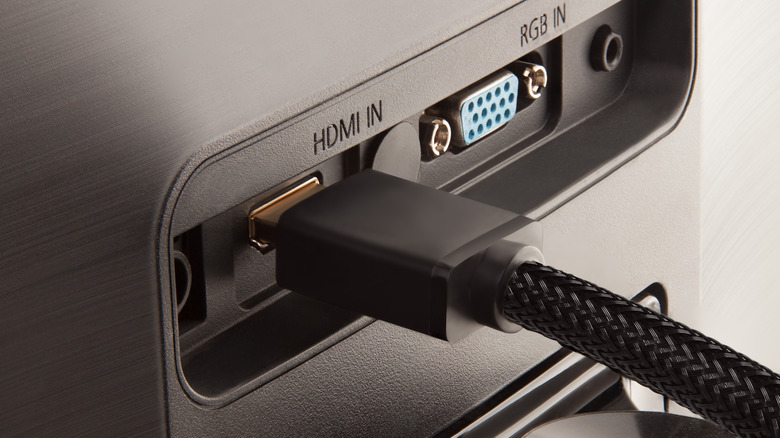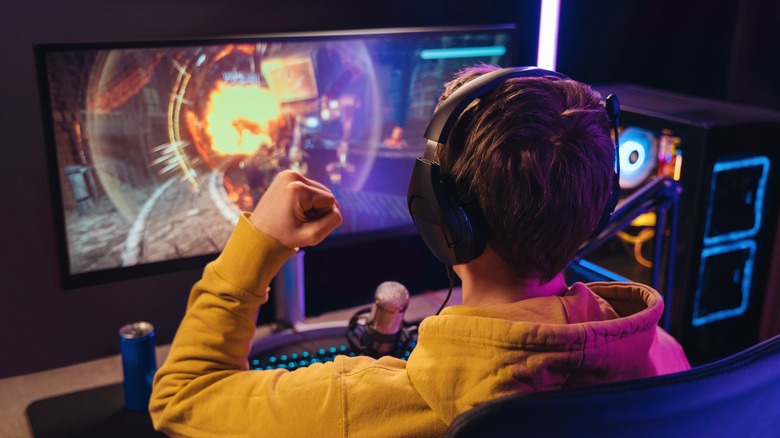5 Things You Need To Know Before Buying A New Monitor
We may receive a commission on purchases made from links.
If you look at advertisements and browse the wares of various retailers, you might notice that every monitor is the single best monitor in the world. How can that be true? Well, it isn't, which is why it's important not to be swayed by ads and to do your research before you spend hundreds of dollars on a new display. We're here to save you time and make the process much less daunting.
It doesn't matter if you need a monitor for office work and browsing the internet, competitive gaming, or photo editing. There are plenty of displays available for every use case. The problem lies in finding one that really matches your needs, and if you're not a pro at computer displays, you may find yourself feeling confused by all the different specifications.
What kind of a refresh rate do you need? What's the difference between an IPS and a TN panel? Is there any point to pick a monitor with a higher resolution, and can your computer handle one? In this guide, we'll take you on a deep dive into the world of monitors so that you can pick the perfect display for you.
Monitor types, explained
Each type of monitor comes with some upsides and some downsides. Regardless of type, you will find that most have similar resolutions. Full HD is the standard size these days (1920 x 1080), followed by Quad HD or 2K (2560 x 1440), and lastly, 4K (3840 x 2160). There might be different resolutions, and the resolution is not too closely tied to size — you will find big monitors with a standard resolution and some 4K displays that are smaller. Choosing a monitor with a higher resolution is more expensive, but it also gives you better image quality, clarity, and more screen real estate.
The vast majority of displays come with a flat panel, but there are also curved and ultrawide monitors. Curved monitors have a slightly curved display and the curvature depends on the model. They can offer greater immersion and are often used for gaming and watching movies.
Ultrawide monitors come with a much wider aspect ratio, such as 21:9 compared to 16:9 of a regular display. Again, these are favored for gaming, but they're also good tools for multitasking and content creation.
Refresh rates
Each monitor comes with a number followed by Hz — this refers to the refresh rate measured in Hertz, which means the number of times per second that your display updates the image on the screen. As an example, if the monitor has a 60 Hz refresh rate (which is the standard), it means that it refreshes the image 60 times per second.
Some of the most common refresh rates include 60 Hz, 75 Hz, 120 Hz, 144 Hz, 165 Hz, 240 Hz, and even 360 Hz. It's easy to fall into the trap of "higher is better" and spend extra money, but the truth is that not everyone needs these extremely high refresh rates.
If you're a gamer and you enjoy esports, you might like to shop for a monitor that goes above 120 Hz. A refresh rate of 144 Hz is often considered to be the sweet spot. Still, in esports higher refresh rates often mean better performance, so if you have the budget and a solid computer, it's worth the money. Even if you don't enjoy fast-paced games, the titles you play will likely look smoother at 144 Hz. Video editors, graphic designers, and animators may also benefit from this.
Panel types
The most common display panel types include IPS (In-Plane Switching), VA (Vertical Alignment), TN (Twisted Nematic), OLED (Organic Light-Emitting Diodes), and mini-LED. IPS panels offer excellent color reproduction and overall image quality. They're best for professionals who deal with photo or video editing, but also for regular users who want nice and bright colors. VA panels tend to have deeper blacks and contrasts than IPS, so while the color reproduction may be worse, the overall image quality might appear nicer to some.
TN panels typically have the fastest response times and the lowest input lag. These monitors are favorites for esports fans. If you pair a TN panel with a high refresh rate, you'll get a monitor that's well-suited to help you win games. Unfortunately, the color reproduction on TN panels is subpar to IPS and VA, so they're not great for color work or watching movies.
Mini-LED is not exactly a panel type — it's more of a backlight technology. A display may simultaneously be IPS and mini-LED, so don't let this confuse you. This technology relies on thousands of tiny LEDs to make the screen even brighter and better in terms of contrasts. OLED screens, on the other hand, are super bright but also expensive — these are mostly recommended for professionals.
Ports and compatibility
Ports are an important consideration if you're buying a monitor. The most common port types include HDMI, DisplayPort, DVI, and VGA — but the latter two are slowly becoming obsolete and technology is moving toward HDMI and DisplayPort instead. However, you can still find them on older monitors, but compatibility will be a problem if your motherboard or graphics card do not support those connectors.
When you shop for a new display, make sure to check whether your existing hardware has the appropriate ports. If not, you should consider buying a different model, although you can also find cheap adapters, such as DVI to HDMI. It's always best to use the optimal technology, though.
Another thing to consider if your computer has a discrete graphics card (GPU) is Nvidia's G-Sync and AMD FreeSync. Both are adaptive sync technologies that adapt your monitor's refresh rate to the frame rates generated by your GPU. It's a good idea to pick a monitor that specifically supports your GPU's technology, but most screens offer dual compatibility, so you won't miss out on much.
Picking the right monitor
When buying a new monitor, remember that your computer is also important — if your PC is better than the monitor, or vice versa, you're missing out on value and performance. If you just want a monitor for general uses, such as browsing the internet and working, the 24-inch Asus VG246H costs just over $150 on Amazon and comes with a 1920 x 1080 screen, 75 Hz refresh rate, and an IPS panel.
Gamers usually want something a little better. The Gigabyte M32U is a strong 32-inch contender, with a 144 Hz refresh rate, 4K resolution, and a bright IPS panel — but it costs $650 on Amazon. For something a little cheaper, pick the LG 27GP850-B, priced at around $370. It's great for 2K gaming and has a stunning Nano IPS panel on top of a 165 Hz refresh rate.
If you're a professional in need of a monitor for photo editing or similar tasks, it can get expensive. The Dell UltraSharp U2723QE is a fantastic option, measuring 27 inches and offering 4K UHD quality with a 400-nit brightness. It costs close to $540. The Dell UltraSharp U3223QE is bigger and better, but it's more expensive at $810.





